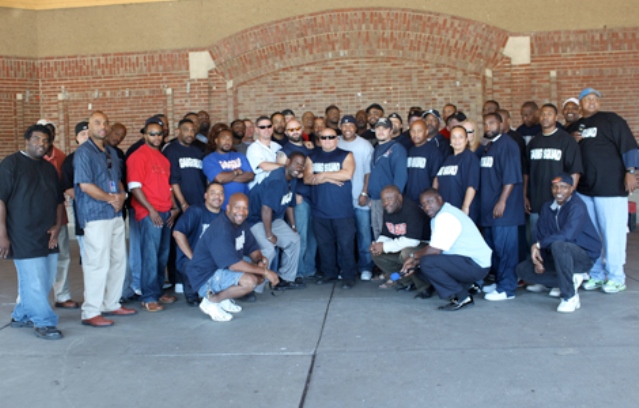
Detroit Police Gang Squad — the biggest gang in town. Residents of Hubbard’s east side neighborhood knew them well. One witness says he has been stopped over 100 times by Detroit police/Photo: National Geographic
Judge Lawrence Talon to ‘review’ motion for relief from judgment during hearing Wed. May 29
One witness swears he saw another man commit the murder, never interviewed by police; another reported victim arguing with a woman just prior to his death, she was arrested but freed
Curtiss Collins swears he was threatened by police to testify falsely that he saw Hubbard running away from the murder scene
Polygraph exam, affidavits from attorney Ronald Giles and others, police report that Collins was arrested for perjury for retracting false testimony, confirm Collins’ statement
Justice Department earlier investigated DPD for soliciting false confessions, arresting and threatening witnesses
By Diane Bukowski
May 28, 2019 (to be updated with links to pertinent documents, etc.)
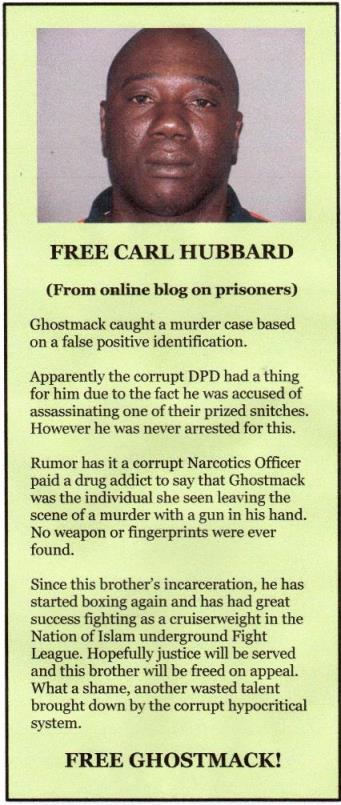 Editor’s note: VOD has withheld some witness names in this story from publication, but they are included in the original affidavits and they have sworn they will testify. In recent weeks, Detroit police and prosecutors have been contacting witnesses in this case with unknown intentions. These witnesses have said they feel threatened.
Editor’s note: VOD has withheld some witness names in this story from publication, but they are included in the original affidavits and they have sworn they will testify. In recent weeks, Detroit police and prosecutors have been contacting witnesses in this case with unknown intentions. These witnesses have said they feel threatened.
DETROIT—Detroiter Carl Hubbard (nicknamed “Ghost” in his east side neighborhood), has been incarcerated since Sept. 23, 1992 for the murder of Rodnell Penn, but has always maintained that he is innocent.
On Wed. May 29, his motion for relief from judgment, with dozens of sworn affidavits attached, some alleging police coercion and subornation of perjury, is scheduled for review by Wayne County Circuit Court Judge Lawrence Talon.
“I was on my way to the store on the corner of Gray and Mack on Jan. 17, 1992 . . . . when I saw [name withheld from publication] arguing with somebody in front of Uncle Peter’s house,” says a sworn affidavit from the only eyewitness to the actual murder to step forward so far. “Then I saw the other guy turn his back and start to walk away from —-. Then I heard some gunshots fired and the guy arguing with — fell to the ground. Then —-stepped over him and started shooting the guy again.”
The witness says he ran back to his house in fear for his life, and did not come forward until 2011 “because I have to live in that neighborhood.” He says definitely the killer was NOT Carl Hubbard.
Another sworn witness who lived nearby says, “After Carl Hubbard got convicted for the murder in front of ‘Uncle Peter’s’ house, everyone was saying that – – – -was the one who really killed the guy. This was due to – – – -believing that the victim had something to do with his brother —-‘s murder on Gray Street.”
In addition, there is an arrest report in Hubbard’s homicide file regarding a female suspect in Penn’s murder, who was seen arguing with him just prior to the event. Her name is redacted from the report.
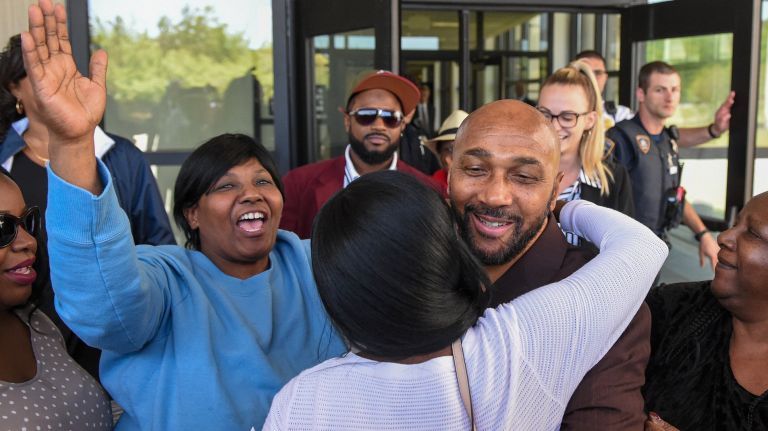
Keith Bush after exoneration; cops and prosecutors never revealed the existence of another likely suspect, also coerced witnesses.
It is questionable whether Detroit police provided the names of the other suspects to the defense. They do not appear to have interviewed witnesses who saw the first suspect, or others in the neighborhood who allegedly identified him as the killer.
If so, Hubbard has an actual innocence claim, and a possible Brady violation, like that which recently helped lead to the exoneration of New Yorker Keith Bush, because police concealed the existence of another suspect.
(Brady violation: “The suppression by the prosecution of evidence favorable to an accused upon request violates due process where the evidence is material either to guilt or punishment. … “Brady requires disclosure of the material exculpatory evidence early enough so that the defense can make use of the information.”)

Then Judge Richard P. Hathaway conducted bench trial in Hubbard’s case, didn’t question why witness recanted statement to police.
Hubbard’s childhood friend Curtiss Collins, the chief prosecution witness at his bench trial, has also provided an affidavit and polygraph exam, stating that police forced him to lie about witnessing Hubbard run away from the scene of the crime, using threats to his freedom.
He did testify on cross-examination at the trial, that his testimony earlier was false, but he was arrested on perjury charges according to a police report and Hubbard’s attorney, and reversed his testimony again the next day. Collins was only 19 at the time.
Collins told VOD in an interview May 25 that his friends and his mother encouraged him to come forward and tell the truth to help free Carl Hubbard. The interview below is backed up by a police arrest report by Sgt. Gales stating that he arrested Collins for perjury in the courtroom at the direction of AP James Gonzalez on Aug. 22, 1992, and by Atty. Giles in his statement.
“. . .I did not witness Carl Hubbard fleeing from where Mr. Rodnell Penn was found dead,
Collins says in his affidavit. “Sergeant [Joann] Kinney forced me to falsely testify at the preliminary examination that Carl Hubbard was running from the scene. . .I was threatened by Homicide Officers Sergeant Kinney and Sergeant [Ronald] Gale with being charged with the murder of Mr. Penn if I didn’t say that I saw Carl Hubbard at the murder scene of Mr. Penn.”
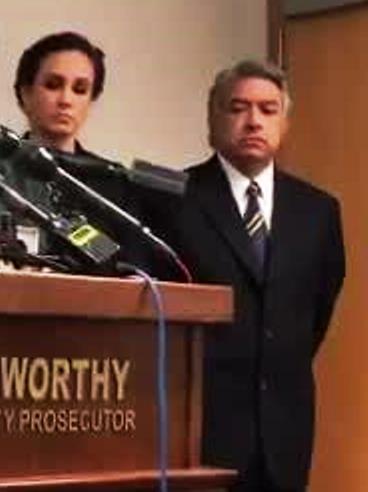
James Gonzalez (r) was formerly a top prosecutor in Kym Worthy’s office. Hubbard says he helped railroad him.
His statement is backed up a polygraph exam, by attorney Ronald Giles, an arrest report from Sgt. Gale which states he arrested Hubbard for perjury at the direction of Asst. Prosecutor James Gonzales, and numerous others who claim that they saw him “crying” in the Wayne County Jail about the police threats, and that he admitted to giving false testimony.
A polygraph report by Michael Anthony, of Forensic Polygraph and Accounting Services, date Feb. 1, 2018, sets forth the test questions:
- Did you see Carl Hubbard shoot that man? Ans. No
- Did you see Carl Hubbard shoot anyone at Gray and Mack in January of 1992? Ans. No.
- Were you present when Carl Hubbard shot that man? Ans. No
Anthony, who is a former police officer, concludes, “It is the opinion of the undersigned examiner based upon the examination given that this subject is being truthful regarding this issue.”
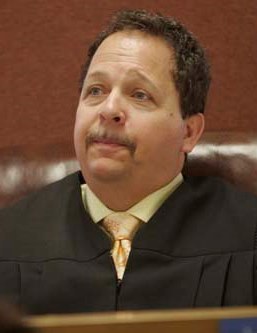
Ronald Giles, now a 36th District Court Judge in Detrot.
Giles says, “I represented Mr. Carl Hubbard in his Bench Trial in Recorders Court. . .In my representation of Mr. Hubbard, there came a time during the testimony when the Prosecution called one Curtis Collins to the witness stand. . .on cross-examination, he drastically changed his testimony and according to my recollection, testified contrary to his testimony at the preliminary examination. . .Mr. Collins was arrested and detained following his trial testimony. To the best of my information and belief, Mr. Collins was released and not charged when his he changed his testimony the following day. . . Mr. Collins’ testimony was especially critical to the Judge’s verdict of guilty against Mr. Hubbard.”
An arrest report signed by Sgt. Ronald D. Gale dated Aug. 31, 1992, states, “Writer responded to Recorders Court. Courtroom #202 and talked with APA James Gonzalez. Writer was directed by APA Gonzalez to arrest the above subject (Collins) for perjury. The above subject was a witness in a homicide case and testified at an exam held in 36th District Court and testified at a trial being held in Recorders Court this date. After being sworn the above subject in direct oppsite (sic) to his testimony at 36th District Court.”
Collins goes on to say that Asst. Prosecutor James Gonzalez , Sergeant Joann Kinney and Sergeant Ronald D. Gale continued to threaten him afterwards.
Before her retirement in 2006, Kinney was exposed as a corrupt cop in at least two cases.
In an article titled, “Detroit Police Inquiry Expands,” which cites Kinney, Detroit Free Press reporters Norman Sinclair and Ronald Hansen wrote, “In another murder case in which the city ultimately paid a five-figure settlement in 1995, a Wayne County Circuit Court judge harshly criticized Detroit police for locking up a mother of two children as a witness and illegally holding her until her 12-year-old daughter and 6-year-old son implicated her in the death.
“Judge Kathleen McDonald said she was outraged that police charged Thoanchelle Taylor with murder without ‘scintilla of evidence,’ as the judge put it. “If I have ever seen a case where the police have manufactured the facts, this is one. I have never had facts as egregious as this case.
“Veteran Homicide Sgt. Joann Kinney testified that she had Taylor locked up as a witness for days without charges against her and said there was no standard procedure as to how long witnesses could be held without being arrested. Kinney also admitted threatening to take Taylor’s children away if she did not cooperate. . .”
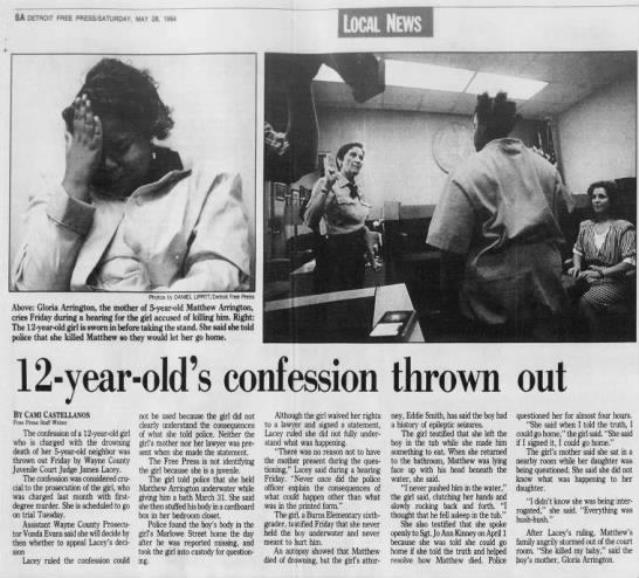 Earlier, in 1992, (above) Kinney interrogated a 12-year-0ld girl charged with the murder of an infant she was baby-sitting for. The child’s attorney said the infant had epilepsy, which likely caused him to drown in the tub when the girl went to the kitchen to get food ready. Juvenile Court Judge James Lacey threw the confession out, citing the fact that the child had neither her mother nor an attorney present during Kinney’s interrogation.
Earlier, in 1992, (above) Kinney interrogated a 12-year-0ld girl charged with the murder of an infant she was baby-sitting for. The child’s attorney said the infant had epilepsy, which likely caused him to drown in the tub when the girl went to the kitchen to get food ready. Juvenile Court Judge James Lacey threw the confession out, citing the fact that the child had neither her mother nor an attorney present during Kinney’s interrogation.
“The girl testified that she left the boy in the tub while she made him something to eat.” the Detroit Free Press reported. “When she returned to the bathroom, Matthew was lying face up with his head beneath the water, she said. “I never pushed him in the water,” the girl said, clutching her hands and slowly rocking back and forth. “I thought that he fell asleep in the tub.”
She also testified that she spoke openly to Sgt. Jo Ann Kinney on April 1 because she was told she could go home if she told the truth and helped resolve how Matthew died. Police questioned her for almost four hours. ‘She said when I told the truth, I could go home,’ the girl said. “She said if I signed it, I could go home.” The girl’s mother said she sat in a nearby room while her daughter was being questioned. She said she did not know what was happening to her daughter. “I didn’t know she was being interrogated,” she said. “Everything was hush-hush.”





It’s a shame that 29 years was taken from his life. They them and all involved corrupt n falsely need to go to Prison. Shame on y’all. FREE CARL HUBBARD
Go lock the corrupt police up this man carl hubbard been lock up for 30 years , they should be held acountable for this